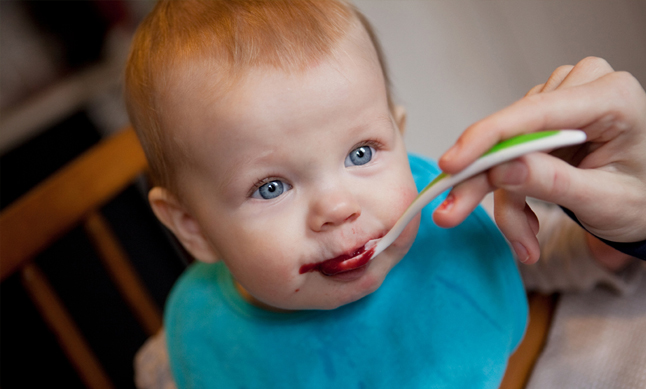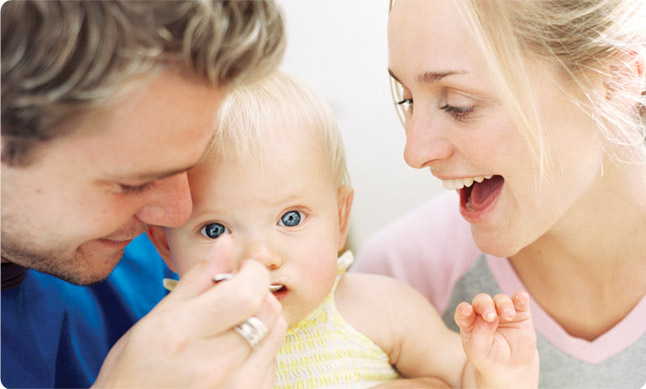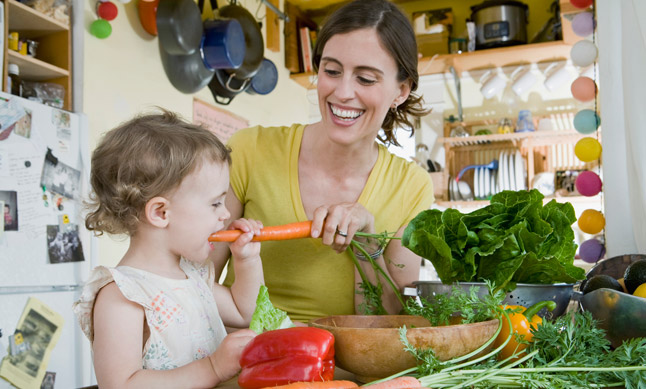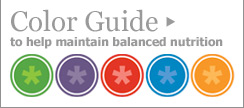Stage

Offering your baby solid food for the first time can be such an exciting experience! So what are the do’s and don’ts to offering new tastes and foods to babies? Here is some helpful information to assist you in making the best choices for you and your little one.
Making sure they are developmentally ready.
It is important to wait until your baby is ready before introducing foods. It takes a few months for their little bodies to be ready to digest the more complex nutrients in foods. Consult with your pediatrician to be sure your child is ready to take on solid foods – typically this will be at five to six months of age. Before introducing solids, babies should be able to hold their neck and head up well on their own. They should also be able to sit up with some support. When you offer foods to your little one, they should be able to move the foods into their months without pushing it back out or letting it dribble out of their mouth. If this doesn’t happen, just wait another week or so and try again.
What foods should you start with?
This is a great question that pediatricians have gone back and forth on for years. Doctors usually suggest offering infant cereal mixed with breastmilk, formula or even water as a beginner food since it is a good source of iron. Some great starter foods include pureed pears, apples, avocado, sweet potatoes and other mild fruits and vegetables. Try introducing one new food every 2-3 days so you can watch for allergic reactions. Try a variety to see what foods your child prefers. Once your baby has mastered simple pureed foods and is ready for the next stage, you can start advancing their meals and mixing different fruits, vegetables and meats. This is also a good time to advance the consistency of the foods to be less pureed and more chunky.
Thinking of making your own baby foods?
Making your own baby food is much easier than you might think. In addition to giving your child a nutritious start, it also provides you with peace of mind, as you know exactly what’s gone into each mouthful–food that is free of additives, extra sugars and other fillers. As an added bonus, you get to pick many different foods that aren’t available in traditional jarred baby foods. Finally, just think of all the money you will save!
Check out some great baby food recipes and our article on homemade baby food storage for tips on making your own baby foods.
Important tips:
Offer foods to your baby when they are sitting in the upright position, not in a bouncer or swing. This can help prevent choking.
Easy timeline:
5-6 months – First introduction to baby foods. Great stage one recipes.
6-8 months – Advance textures and start mixing different foods together. Stage two recipes .
9-12 months – Babies start using their fingers to pick up foods. Babies usually try to start feeding themselves before this point but usually they are using the whole hand to pick up foods and push them into their mouths. Try these stage three and stage four recipes.
Check out our feeding stages chart for additional food and serving size information.
Have you tried making your own baby food yet? What is your number one reason wanting to do so? *** GIVEAWAY IS NOW CLOSED*** Leave a comment below and you will be entered for a chance to WIN a Designed to Nourish™ Puree and Simple™ Blender! TEN winners will be randomly selected from all comments (U.S. residents only). Check back on Thursday, August 9th when we will post the winners!
Here are the WINNERS: Natalia, Clarissa, Kelsey, Stephanie, Donna, Genie, Ellen, Megan, Katrina and Ashlea. If you are one of the winners you will be contacted by e-mail. Thanks to everyone for commenting!
****
Natalia says:
July 31, 2012 at 10:12 pm
I love to make my own food for a baby it’s easy and you know for sure it’s healthy.
****
Clarissa says:
July 31, 2012 at 10:08 pm
I would love to make my own baby food – mainly so I know what goes into her food. I would feel much better knowing I prepared it myself :)
****
Kelsey says:
August 1, 2012 at 12:05 am
I want to make my baby’s food so I know exactly what he is eating. No chemicals, no preservatives.
****
Stephanie moody says:
July 31, 2012 at 10:12 pm
I like to know what is in the food my daughter is eating :)
****
Donna says:
August 1, 2012 at 4:04 am
I have never tried making my own baby food. I but I would like to start with my last baby here she is only a month old, but money is tight and I would like to feed my baby what we eat instead of processed food where I have no idea what is in it. Or how long ago it was made. For this being my last baby I want to do things right.
****
Genie says:
July 31, 2012 at 10:42 pm
I would love this because i would be able to make my food for my little one as well. He would eat what i am eating so when he fusses i can eat a spoon full as well to show him its good stuff.
****
Ellen says:
July 31, 2012 at 10:23 pm
It saves SO much money and the best part is…it helps my little one be a healthy eater.
****
Megan says:
August 1, 2012 at 1:15 am
I like creating my own flavor combinations!
****
katrina watson says:
August 1, 2012 at 12:21 pm
As parents you want the absolute best for your children. My son is a breastfed baby and I am continuing to be healthy by serving organic foods. Plus you know what you’re serving your baby, and it’s fun to experiment with your own recipes/combinations.
****
I used all Dr. Browns products with my son and with another baby on the way I would love to have this for my little one!
Stage

Adding solid foods to mealtime is an exciting and important milestone for you and your baby, ranking up there with crawling and saying that long-awaited first word. Not only is your baby moving past the extrusion reflex and learning how to eat from a spoon, but she is finally getting to enjoy some of the same foods you love. Different than the bottle or breastfeeding, this is a new opportunity for bonding at the dinner table, and depending on your child’s aim, that bond may be literal on occasion with the flinging of food. Regardless of how much food makes it into baby’s mouth, each new flavor will offer a new experience. Each experience will contribute to food preferences that will last throughout your child’s lifetime. Before you move into the world of solid foods, it helps to be prepared. And you will need to add a few new feeding items to your child’s collection of bottles. Here are the basics:
• A high chair. Follow the safety guidelines set by the Juvenile Products Manufacturers Association
(www.jpma.org).
• Bibs, bibs and more bibs. Feeding time will be fun, but it will not be pretty. In addition to
experiencing new flavors, your child will also learn a new skill that requires coordination and spatial intelligence. Embrace the mess. Just make sure to cover baby with a bib that is comfortable and easy to clean.
• Bowls and plates. Choose serving dishes that are small (to aid in determining portions) and easy
to hold. Dishwasher safe items are a plus too!
• Feeding spoon. The best first spoon for baby will be one that is easy for mom to hold onto. Longer
handles are easier to maneuver, especially when your little one begins to help direct the spoon to face movement. Choose a spoon that is appropriately sized for baby’s small mouth and is not hard on sensitive gums.
• Training cup. Practicing drinking with a training cup will help improve feeding skills. When baby
begins drinking from a cup, choose a one with a soft spout that eases the transition a bottle nipple to
cup. As the comfort level with a cup rises and teething occurs, begin using cups with harder spouts
that are more durable when chewed.
Last but not least, make sure you come to the table armed with patience. This is truly a learning experience for baby, and it will take a while before she becomes a pro. Have fun, explore together, and don’t worry about whether or not she is getting enough solid food. During the first year of life, your child’s main source of nutrition will be from breast milk or formula. That’s nature’s way of working in a learning curve, leaving you time to enjoy this precious period in your little one’s development.
Stage

When your little one is finally ready to move beyond breastfeeding or the bottle to solid foods, the idea of introducing new sources of nutrition can be an exciting, but often confusing, proposition. What foods are best for baby’s first real eating experience and in what order should you include them? You’ll find many contrasting opinions regarding the veggies, fruits, grains and meats that are essential to your growing child’s diet. While each of these food groups is important for development and growth, deciding what is best to feed your baby first is a source of much debate.
First things first. Consult with your pediatrician to be sure your child is ready to take on solid foods – typically this will be at five to six months of age. Iron-fortified cereals like rice, barley and oats are a natural starting point. So what food group comes next? Here’s where it gets a little murkier. When my wife and I were going through this growth experience with our baby daughter, our pediatrician suggested experimenting to see what foods peaked our child’s eating interest. The problem was, she liked some foods much more than others – she seemed to only want pears and other fruits, for instance – and we worried that she was missing out on important vitamins and nutrition.
Interestingly enough, this a common challenge, and there are differing schools of thought. According to many pediatricians, the trick is to introduce baby to the blander foods, such as vegetables and grains first. After baby develops a taste for these, fruits and other foods that naturally have more flavor should come shortly after. This way you help to avoid a “fruits first = veggies never” reaction in your child. However, the American Academy of Pediatrics recently published findings that indicate while babies are born with a preference for sweets, the order of introducing foods does not change this.
So what’s the right solution? Like most things regarding your baby, there is not a “one-size-fits-all” answer. You’ll find that working closely with your pediatrician and paying close attention to your little one’s eating habits will help you to develop a nutrition plan that is as individual as your child. And by the way, our daughter is now a huge veggie lover – who would have thought? Bon appetit!






